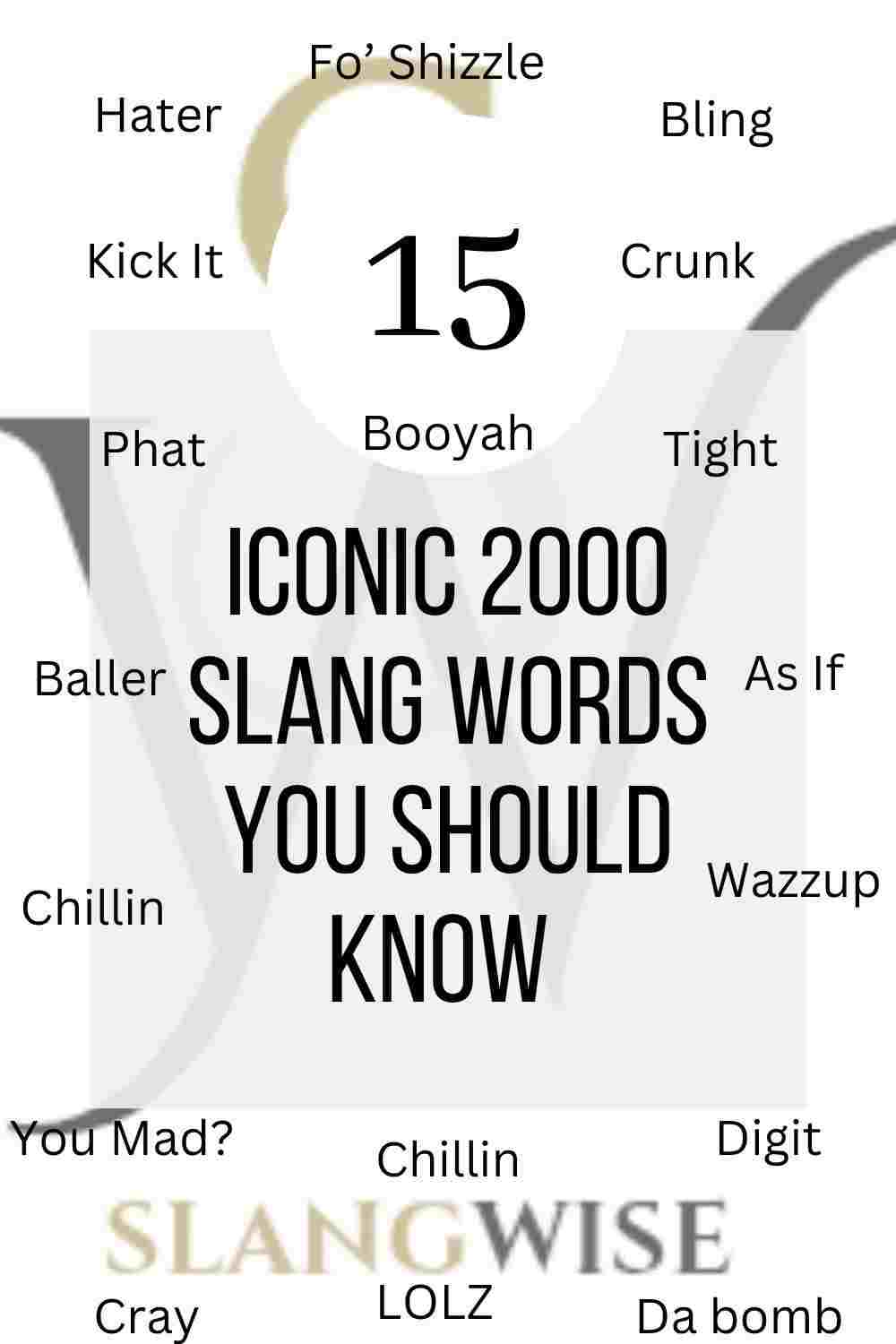Flipping open a flip phone to send a text message and customizing a MySpace profile were hallmarks of the 2000s; an era shaped by dial-up internet, pop-punk anthems, and reality TV drama.
2000s slangwords like “phat,” “as if,” and “booyah” served as linguistic badges of belonging, reflecting the decade’s music, movies, and early social media platforms.
These 15 iconic terms weren’t merely fads; they embodied the cultural pulse of an internet on the cusp of ubiquity and defined how groups connected.
Understanding these slang words offers insight into how language both mirrored and influenced youth culture at the time.
Table of Contents
In a Nutshell
- Iconic 2000s Slang Terms: Bling, Crunk, Fo’ Shizzle, Hater, Kick It, Phat, Tight, As If, Baller, Chillin’, Wazzup (What’s Up), You Mad?, Digit (for “Digital”), Cray, LOLZ, Da bomb, Booyah.
- Cultural Reflection: Each slang term echoed the prevailing trends in music, film, and nascent social media, think boy bands, reality TV, and the first viral videos, revealing how slang functions as a barometer for pop culture.
- Contextual Precision: Proper usage of phrases like “bling” or “da bomb” required awareness of tone and setting; using them accurately highlights the nuances that made 2000s slang feel authentic.
SlangWise Tip
Refer back to these 2000s classics to add nostalgic flair and cultural credibility to modern conversations.
15 Popular 2000’s Slang Terms To Know
1. Bling
Bling Meaning: Flashy jewelry or accessories that signify wealth and status. It was popularized by hip-hop artists in the late 1990s; “bling” appeared in songs like “Bling Bling” (1999) and spread across mainstream media in the early 2000s.
In short: Bling means ostentatious, status-driven jewelry.
Example:
- “That rapper’s video showcased so much bling it glowed under stage lights.”
2. Crunk
Meaning: A hyper-energetic subgenre of hip-hop or the state of being extremely excited.
Crunk originated in Southern U.S. clubs around 1999; Lil Jon & the East Side Boyz popularized “crunk” tracks in the early 2000s.
In short: Crunk means intense energy, often linked to music or partying.
Example Usage:
- “Turn up the volume and get crunk in the club tonight.”
3. Fo’ Shizzle
Definition: Fo’ Shizzle is a playful affirmation equivalent to “for sure.” Derived from West Coast hip-hop, most famously used by Snoop Dogg circa 2000; part of a broader trend of “-izzle” suffixing.
In short: Fo’ Shizzle means definitely or absolutely.
For Example:
- “Heading to the game? Fo’ shizzle, gotta snag front-row seats.”
4. Hater
Meaning of Hater: Someone who criticizes or resents another’s success.
Though “hater” existed earlier, it gained mass appeal through early-2000s rap lyrics and reality TV catchphrases.
In short: Hater means person who disparages or envies.
Example Usage:
- “Ignore the haters, focus on building momentum.”
5. Kick It
Kick It Meaning: To hang out or spend time relaxing with friends.
Borrowed from late-1990s urban youth culture; “kick it” became ubiquitous in TV shows and teen films.
In short: Kick It means chill or socialize casually.
Usage:
- “After school, let’s kick it at Mike’s place and play video games.”
6. Phat
Phat: An acronym meaning “Pretty Hot And Tempting,” used to praise someone or something as excellent.
Coined in early 1990s hip-hop circles; peaked in widespread use among teens in the 2000s.
In short: Phat means outstanding or attractive.
Example:
- “That beat is phat, got everyone on the dance floor.”
7. Tight
Meaning: Phat is something very good or impressive; alternatively, to indicate a close friendship.
Originated in African American Vernacular English and crossed into mainstream youth vocabulary by the 2000s.
In short: Tight means awesome (or describe a strong bond).
Example:
- “Your new car is tight, did you customize it yourself?”
Read Also: The modern equivalent: 75 Ultimate Gen Alpha slang words of 2025
8. As If
Meaning: As if is a dismissive retort meaning “I don’t think so” or “yeah, right.”
Cemented by the 1995 film Clueless and carried into everyday speech throughout the early 2000s.
In short: As If means skeptical refusal or mock surprise.
Example Usage:
- “She said she’d quit coffee cold turkey, As if!”
9. Baller
Baller Meaning: A person who lives lavishly or excels at sports; sometimes used sarcastically for someone who overspends.
Derived from basketball terminology; expanded by hip-hop culture in the 2000s.
In short: Baller is someone wealthy or exceptionally skilled (often in sports).
Usage:
- “He just dropped nine grand on a watch, definitely a baller move.”
10. Chillin’
Chillin Meaning: Relaxing without stress or obligation, often synonymous with “kick it.”
Chilling was rooted in 1990s surf and skate culture; proliferated via MTV shows and early social media in the 2000s.
In short: Chillin’ means taking it easy, kicking back.
For Instance:
- “Saturday afternoon: just chillin’ by the pool with some cold drinks.”
11. Wazzup (What’s Up)
Meaning: A casual greeting equivalent to “What’s happening?”
Origin: Popularized by the Budweiser “Whassup?” commercial campaign (1999–2002); spawned countless parodies and everyday usage.
In short: Wazzup means casual “hello” or “what’s going on?”
For Example:
- “Wazzup, man? Ready for the concert tonight?”
12. You Mad?
Meaning: You mad? is a taunt suggesting someone is upset or envious, often used playfully.
It Emerged from online gaming and forum culture in the early 2000s; migrated into broader teen vernacular via memes.
In short: You Mad? means mild provocation implying jealousy.
Example Usage:
- “Beat you in that match, You mad?”
READ ALSO: 15 Iconic 80s Slang Words That Defines The Era
13. Digit (for “Digital”)
Meaning: Short for “digital,” used to describe activities or culture tied to early internet and mobile tech.
It wad coined as smartphones and social media platforms began dominating youth culture.
In short: Digit is related to digital technology or online life.
Example:
- “That party was totally digit, everyone was Snapchatting the whole time.”
14. Cray
Meaning: Cray in slang is abbreviation of “crazy,” used to emphasize wild behavior or situations.
It gained traction through hip-hop lyrics (e.g., Kanye West’s “Runaway,” 2010) but roots trace to late-2000s rap collaborations.
In short: Cray means extremely crazy or outrageous.
Example:
- “Last night’s concert was cray, crowd went wild when the headliner jumped off stage.”
15. LOLZ
LOLZ Meaning: A playful variant of “LOL” (“laughing out loud”), often used sarcastically.
It was born in early chat rooms and instant messaging circa 2000; “LOLZ” signaled amusement tinged with irony.
In short: LOLZ is ironic or exaggerated laughter.
Example Usage:
- “He tried to dance and fell over, LOLZ.”
16. Da bomb
Da Bomb Meaning: A superlative term used to describe something excellent or outstanding. It gained traction in late 1990s hip-hop and pop culture, appearing in songs like LL Cool J’s “Phenomenon” (1997) and spreading through movies and teen magazines in the early 2000s.
In short: Da bomb means “the best” or “top-tier.”
Example:
“That new video game is totally da bomb, graphics and gameplay are next level.”
17. Booyah
Booyah Meaning: An exclamation of triumph or excitement, often used to celebrate a win or success. Popularized by ESPN sportscasters in the late 1990s (notably Stuart Scott), it also appeared in video games (e.g., NBA Live) and teen sitcoms throughout the 2000s.
In short: Booyah means “Yes! I nailed it!”
Example:
“He hit that shot at the buzzer, booyah!”
Related Terms
- For a broader look at timeless expressions, see 36 Most Iconic Slang Words of the Past 50 Years.
- For classic vernacular that endures beyond decades, consult 10 Classic Slang Words That Never Get Old.
Concluding Thought
These 15 terms capture the energy and innovation of 2000s youth culture, illustrating how language both reflected and fueled trends in music, film, and early social media.
By appreciating phrases like “as if,” “bling,” and “clink,” readers gain insight into a pre-smartphone era where slang served as a powerful social marker.
Revisiting this lexicon underscores the rapid evolution of language and highlights the lasting influence of 2000s pop culture on today’s vernacular.
Frequently Asked Questions
Many of these terms originated in hip-hop, reality TV, or early social media platforms. Their catchy nature and constant reinforcement through music videos, TV shows, and chatroom banter solidified their popularity among teens and young adults.
Some, like “bling” and “hater”, remain in circulation, although their peak cultural currency was in the 2000s. Others, such as “fo’ shizzle” or “you mad?,” are now viewed as nostalgia-worthy tthrowbacks.
Yes, deploying them can add retro flair or humorous effect. Be mindful of audience and setting: deploying 2000s slang in professional or formal writing may come across as dated or ironic rather than authentic.
Early forums, instant-messaging platforms (AIM, MSN), and the rise of viral commercials (e.g., Budweiser’s “Whassup?”) amplified certain terms rapidly. Memes and peer-to-peer sharing fostered a feedback loop that ingrained these expressions in everyday vocabulary.
About the Author
Agboola John is the founder of SlangWise.com and a leading researcher of generational slang trends. With extensive linguistic analysis and cultural expertise, John decodes evolving vernacular to help readers stay informed and fluent in modern slang.

